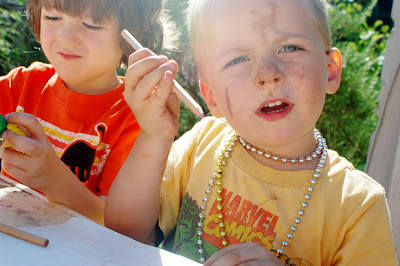 |
| 3D brain model/puzzle. |
We're building on what we started yesterday. On the way to our table, W hollered, "Can we do ears today?" I replied, "I'll write down that you want to research ears too so that I remember. Today we're following up on the brain work we started. I have some new research to share with you! And I want to hear what you guys are thinking about!"
How Did I Invite Them?
I took some tickets and a sharpie outside. I quietly walked up to the children who had previously shown interest, and I whispered, while writing a B and an R on the ticket, "Are you interested in coming to do some research in the BR [making the sound brrrr] for Brains group? Yes? Here's a BR for Brains ticket! You can take it over to the gate and wait for the others!"
 |
| Parts of the brain diagram. |
I placed on the table the same 3D brain model as yesterday, the same paper as yesterday, a little diagram of the brain with information about the different parts, and colored pencils (versus the sharpies of yesterday).
I decided to put my phone camera on video this time (for the audio so that I wouldn't need to write today), and I placed it out of the way on the bench. I brought my Nikon for taking pictures.
What Was My Intention For Today?
My goals for our time together were to
* Reflect on yesterday's work
* Offer a provocation to build
* Follow their lead to see what they're working on
* Document in order to be able to share with parents and reflect with children tomorrow
I really, really loved the conversations yesterday about how the brain changes depending on your emotions. My interest + children's conversations (so I was hoping also their interest) meant that I did some research on that process and came in ready to insert little bits of info based on where the conversation went. My intended provocation was to confirm that the brain has different parts for different uses, to talk about how the frontal lobe is the area that processes emotions, and to offer the chance to draw their brains feeling certain emotions.
What Did We Do? (little bits below... not a whole transcription!)
I opened with my emotion provocation: "Yesterday, you guys were talking about how your brains look different if you're troubled or happy. Also, you were talking about how there are different parts to the brain. And I was really curious about that! So I did some research! Sure enough, there is a special part of your brain that is for processing your emotions! It's right here in the front, and it's called the frontal lobe." We touched the front of our heads, remembering that the skull is protecting our brains. We looked at the diagram. We looked at the model. They started taking the model apart and asking questions.
 |
| T works with the 3D mold puzzle the entire time! |
Me: Oh, I'm looking on the diagram here... It says that's the brain stem.
M: What's that for?
Me: I can read this part here, it says: When your brain wants to send a message to your body, the message goes down your brain stem into your body!
G: Because brains usually fit in your head.
Me: Yes! Brains usually fit in your head!
M: And your spine is on the back.
Me: And your spine is on the back!
W: What's this part? What does it say?
Me: I'm reading right here, it says: The cerebellum is the part of your brain that deals with movement. HEY! Remember yesterday, W was holding this part, and she asked if it jumped! And it DOES help us jump! The cerebellum send the messages down the brain stem to our body about jumping or running or...
W: Drawing!
M: I'm going to draw the
cerebellum!
W: I'm drawing the cerebellum too!
M: I'm gonna do the stripes right here.
W: This, this I'm drawing right here, this is where the energy comes from. This is what the brain looks like.
Me: Tell me about that! You're pointing to where you drew the cerebellum and then to the blue part that's the brain stem.
W: Yes, the energy comes from the cellabella-um and goes down the brain stem into the body.
 |
| Brain "energy" traveling from cerebellum through brain stem to body. |
W: It's telling me to draw.
Me: So, like, it's telling your hand to move around?
W: Yep. And this little part, this is where the energy to jump is.
 |
| "Can you see that I'm drawing a brain here? It has lots of lines." |
Me: Whoa!!! What would happen if our brains blew away? (in a very silly voice)
W: You couldn't think!
G: That would be crazy!
At one point, G realized that he lost his BR ticket. I made him a new one, talking through the way I write the letters B and R. Some children also decided to write the letters.
 |
| BR for brains! And a detailed cerebellum, which helped M write and draw this. |
My guess that the children would be into the emotional side of brain work was way off (perhaps for today? perhaps for always? who knows! If they get into it at some point, I've got the research in my back pocket.).
Instead, they jumped on some super cool concepts that
* Our brain sends messages to our body.
* Different parts of the brain send different messages.
Comments
Post a Comment